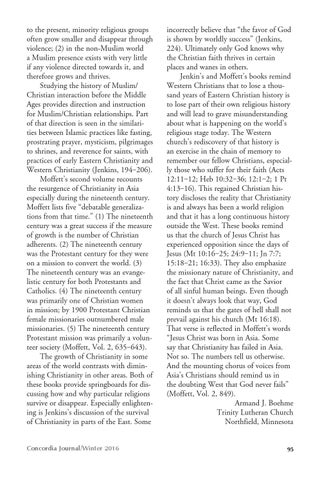to the present, minority religious groups often grow smaller and disappear through violence; (2) in the non-Muslim world a Muslim presence exists with very little if any violence directed towards it, and therefore grows and thrives. Studying the history of Muslim/ Christian interaction before the Middle Ages provides direction and instruction for Muslim/Christian relationships. Part of that direction is seen in the similarities between Islamic practices like fasting, prostrating prayer, mysticism, pilgrimages to shrines, and reverence for saints, with practices of early Eastern Christianity and Western Christianity (Jenkins, 194‒206). Moffett’s second volume recounts the resurgence of Christianity in Asia especially during the nineteenth century. Moffett lists five “debatable generalizations from that time.” (1) The nineteenth century was a great success if the measure of growth is the number of Christian adherents. (2) The nineteenth century was the Protestant century for they were on a mission to convert the world. (3) The nineteenth century was an evangelistic century for both Protestants and Catholics. (4) The nineteenth century was primarily one of Christian women in mission; by 1900 Protestant Christian female missionaries outnumbered male missionaries. (5) The nineteenth century Protestant mission was primarily a volunteer society (Moffett, Vol. 2, 635‒643). The growth of Christianity in some areas of the world contrasts with diminishing Christianity in other areas. Both of these books provide springboards for discussing how and why particular religions survive or disappear. Especially enlightening is Jenkins’s discussion of the survival of Christianity in parts of the East. Some Concordia Journal/Winter 2016
incorrectly believe that “the favor of God is shown by worldly success” (Jenkins, 224). Ultimately only God knows why the Christian faith thrives in certain places and wanes in others. Jenkin’s and Moffett’s books remind Western Christians that to lose a thousand years of Eastern Christian history is to lose part of their own religious history and will lead to grave misunderstanding about what is happening on the world’s religious stage today. The Western church’s rediscovery of that history is an exercise in the chain of memory to remember our fellow Christians, especially those who suffer for their faith (Acts 12:11‒12; Heb 10:32‒36; 12:1‒2; 1 Pt 4:13‒16). This regained Christian history discloses the reality that Christianity is and always has been a world religion and that it has a long continuous history outside the West. These books remind us that the church of Jesus Christ has experienced opposition since the days of Jesus (Mt 10:16‒25; 24:9‒11; Jn 7:7; 15:18‒21; 16:33). They also emphasize the missionary nature of Christianity, and the fact that Christ came as the Savior of all sinful human beings. Even though it doesn’t always look that way, God reminds us that the gates of hell shall not prevail against his church (Mt 16:18). That verse is reflected in Moffett’s words “Jesus Christ was born in Asia. Some say that Christianity has failed in Asia. Not so. The numbers tell us otherwise. And the mounting chorus of voices from Asia’s Christians should remind us in the doubting West that God never fails” (Moffett, Vol. 2, 849). Armand J. Boehme Trinity Lutheran Church Northfield, Minnesota 95
